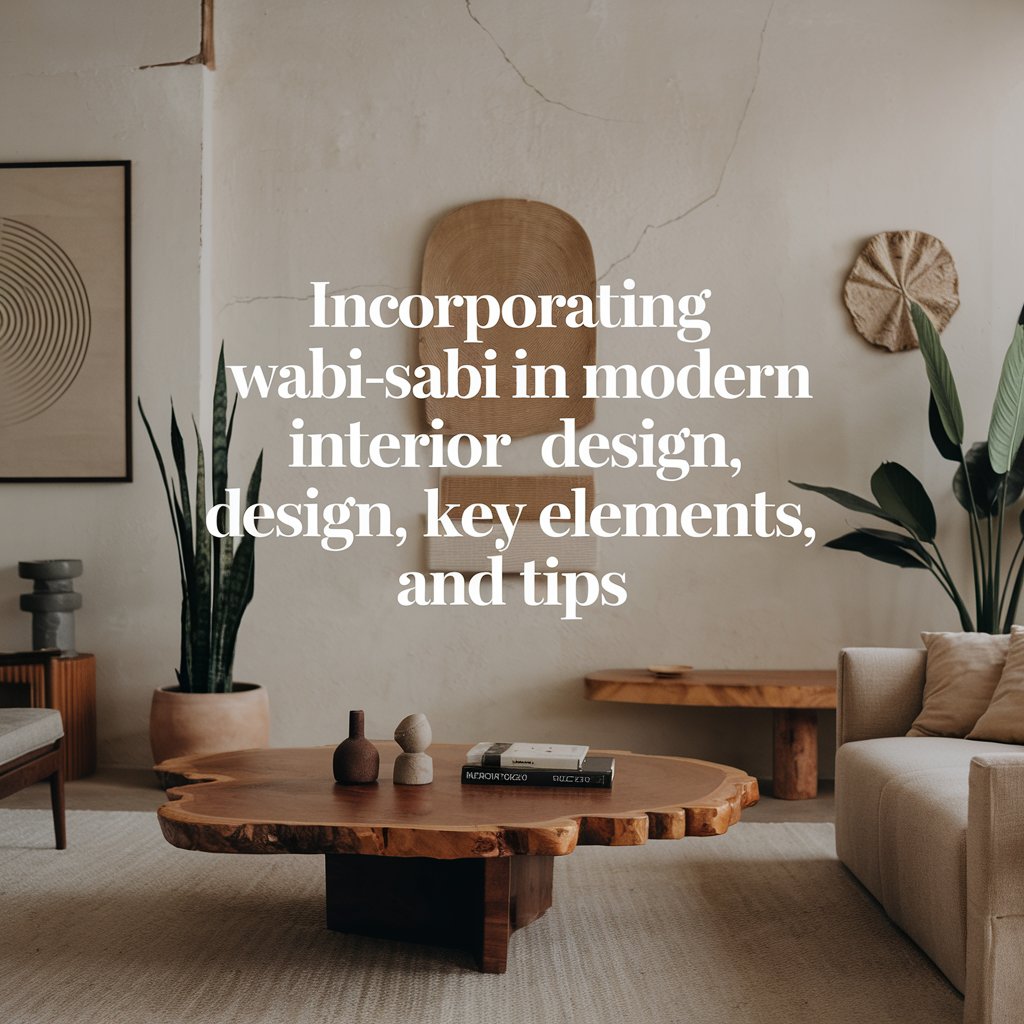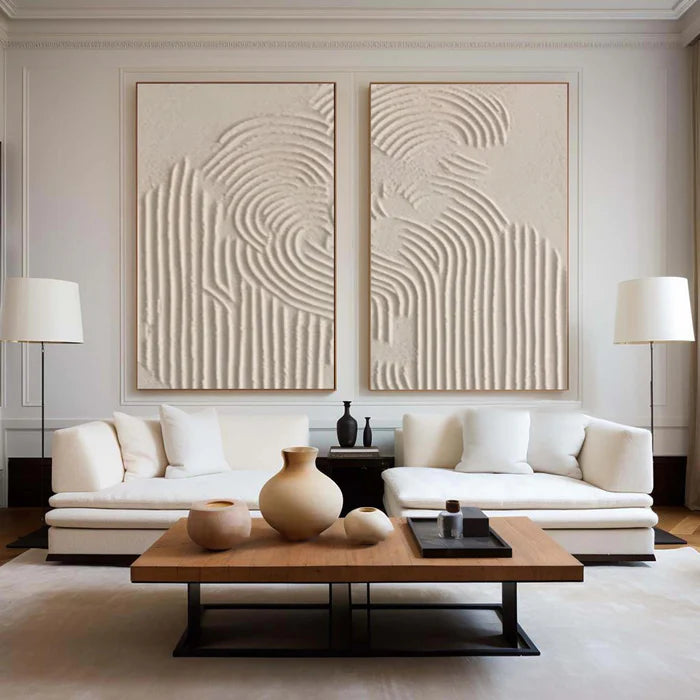
Incorporating Wabi-Sabi in Modern Interior Design, Key Elements, and Tips
Wabi-Sabi design celebrates the beauty found in imperfection and transience. Rooted in ancient Japanese philosophy, this style embraces natural materials and the passage of time. Wabi-Sabi invites you to find style in simplicity and authenticity. It transforms living spaces into serene retreats that reflect a deep connection to nature and the human experience.
Let’s discuss incorporating Wabi-Sabi into modern interior design and minimalist design.
What is Wabi-Sabi Interior Design?

Wabi-sabi interior design finds beauty in imperfection and transience. This style embraces the imperfect and incomplete aspects of life. It celebrates the simple and the natural. Inspired by ancient Japanese philosophy, Wabi-Sabi values the raw and unpolished.
It highlights the beauty in aging and wear. Cracked ceramics and weathered wood become focal points. This style focuses on authenticity and natural materials. The goal is to create a space that feels genuine and lived-in.
The essence of Wabi-Sabi lies in its respect for the passage of time. Each mark and imperfection tells a story. Spaces designed with Wabi-Sabi in mind radiate tranquility and simplicity.
Check out our: Wabi Sabi Wall Art Collection
How Can You Incorporate Wabi-Sabi into Your Home?
Start with natural materials. You can choose wood, stone, and clay for their authentic qualities. Opt for handmade or vintage items to add character. Then, select pieces that showcase imperfections and history. Embrace imperfections in your decor. Highlight the natural flaws of materials. Display items like chipped pottery or worn textiles. Let these imperfections tell a story.
Create a tranquil environment. Declutter to achieve a calm and open space. Keep furniture simple and functional. Use neutral tones and earthy hues for a serene backdrop. Incorporate plants to bring a touch of nature indoors.
Focus on natural light. Use minimal window treatments to maximize light. Place mirrors strategically to reflect sunlight. Ensure that light enhances the textures and materials in the room. Apply these principles to cultivate a home that embodies its beauty.
Enhance the space with textures. Combine rough wood, unpolished stone, and soft textiles. Add layers of texture for depth and comfort. Balance these elements to create an inviting atmosphere.
What Are the Key Elements of Wabi-Sabi Interior Design?
Embrace asymmetry and irregularity. Opt for off-center artwork and mismatched furniture. So—it is suggested that you choose arrangements that feel spontaneous and relaxed. Highlight textures. Incorporate a variety of textures like rough linen and smooth stone. Let these textures engage the senses and showcase natural materials.
- Prioritize simplicity and minimalism.
- Curate possessions to those with meaning and function.
- Maintain a clean, uncluttered space where each item has a purpose.
- Use a neutral color palette.
- Select earthy tones such as warm beige, muted greens, and soft grays.
- Allow these colors to create a calm and unobtrusive backdrop.
- Incorporate natural materials.
- You should choose wood, stone, and clay for their organic qualities.
- Include textiles like linen and wool to enhance tactile comfort.
- Focus on authenticity.
- You have to choose pieces that reflect their history and character.
- Display items that show signs of wear and age.
- Let these details add depth and narrative to the space.
How Does Wabi-Sabi Compare to Japandi Design?
Wabi-sabi focuses on imperfection and natural aging. It celebrates flaws and time's impact on objects. Japandi blends Japanese minimalism with Scandinavian functionality. It emphasizes sleek lines and polished aesthetics.
Wabi-sabi favors rustic home decor and time-worn elements. Japandi prefers clean, modern design. Both styles appreciate simplicity and natural materials. Wabi-Sabi highlights worn textures, while Japandi opts for smooth, refined finishes.
It showcases uneven, handmade items. Japandi features precise, functional décor. Wabi-Sabi values authenticity through visible wear. Japandi seeks harmony through well-crafted, practical pieces. Both styles aim for serene, balanced spaces. Wabi-Sabi finds beauty in imperfection. Japandi balances form and function. Each offers a unique path to tranquility and elegance.
What Colors and Textures Are Essential in Wabi-Sabi Design?
Wabi-sabi focuses on natural aging and imperfections. It celebrates flaws and time's impact on objects. Key elements include uneven, handmade items. You can choose rough linen, smooth stone, and earthy tones. These textures engage the senses and create a calming backdrop.
It values authenticity and simplicity. Neutral colors and natural materials enhance the serene atmosphere. Each piece contributes to a harmonious and inviting space.
How Can Natural Materials Enhance Wabi-Sabi Interiors?
Natural materials bring warmth and authenticity to Wabi-Sabi interiors. Wood adds character through its grain and imperfections. Stone offers a timeless, rugged appeal. Clay provides a natural, tactile quality.
Wood furniture showcases unique textures and aging. Stone surfaces create a grounded, earthy feel. Clay pottery adds an organic touch with its hand-formed irregularities. Linen and cotton textiles enhance comfort with their natural textures.
These materials highlight the beauty of age and wear. They create spaces that feel lived-in and genuine. If you are using natural materials, it supports Wabi-Sabi’s emphasis on simplicity and authenticity. Each piece tells a story, contributing to a serene, harmonious environment.
What Are Some Practical Tips for Embracing Wabi-Sabi in Your Space?
You can choose items with characters. Look for handmade or vintage pieces. These items often have unique imperfections that add charm. Declutter to highlight meaningful objects. Select a few cherished items to display. Avoid overcrowding surfaces and shelves. Opt for natural materials. Wooden furniture, stone surfaces, and linen textiles fit the Wabi-Sabi style. These materials enhance authenticity and comfort.
Embrace imperfections in your decor. You can choose pieces that show signs of wear. Appreciate the history and uniqueness they bring to your space. Incorporate subtle, earthy colors. Use neutral tones to create a calming backdrop. Let natural light enhance the textures and details of your decor.
Balance simplicity with functionality. It is important to choose items that serve a purpose while adding aesthetic value. Avoid excess and focus on what truly resonates with you. These tips help create a space that feels authentic and serene. Wabi-Sabi invites you to appreciate the beauty in the imperfect and transient.
How Does Wabi-Sabi Design Reflect Japanese Philosophy and Zen Principles?
Wabi-sabi design draws from Japanese philosophy. It embodies the appreciation of imperfection and the passage of time. This approach aligns with Zen principles, which value simplicity and mindfulness.
Zen Buddhism influences Wabi-Sabi with its focus on natural beauty. Zen teaches that imperfections are inherent and should be embraced. This belief is reflected in the use of raw, natural materials in design and simple forms in Wabi-Sabi interiors. The concept of Wabi emphasizes understated beauty. It celebrates the rustic and the modest, which rejects the pursuit of perfection. The idea of Sabi highlights the style that comes with age and wear.
Wabi-Sabi encourages living in the moment. It teaches us to find peace in the present and to appreciate the fleeting nature of life. This philosophy promotes a serene, mindful approach to both design and daily living.
This creates spaces that feel authentic and grounded. It captures the essence of Japanese philosophy by embracing life's natural cycles and imperfections.
Ready to Transform Your Space with Wabi-Sabi?
Embrace the beauty of imperfection and simplicity in your home. Start incorporating Wabi-Sabi design elements to create a space that reflects tranquility and authenticity. Explore natural materials, celebrate imperfections, and let your home tell a unique story.
Want personalized guidance on how to apply Wabi-Sabi in your space? Contact us today to schedule a consultation and begin your journey towards a beautifully imperfect home. Let’s make your vision a reality.
Conclusion
Wabi-Sabi design invites you to find beauty in the imperfect and the transient. This philosophy is rooted in Japanese tradition. It encourages you to celebrate natural materials and unique imperfections. Wabi-Sabi can transform your home into a serene, authentic sanctuary.
As you explore this design style, focus on simplicity, natural textures, and the story behind each piece. Let your space reflect the natural flow of life and the charm of aging. Wabi-Sabi is not just a design choice—it's a way to connect deeply with your surroundings.
Start incorporating Wabi-Sabi principles today and discover how a thoughtful, minimalist approach can create a home filled with character and peace.



